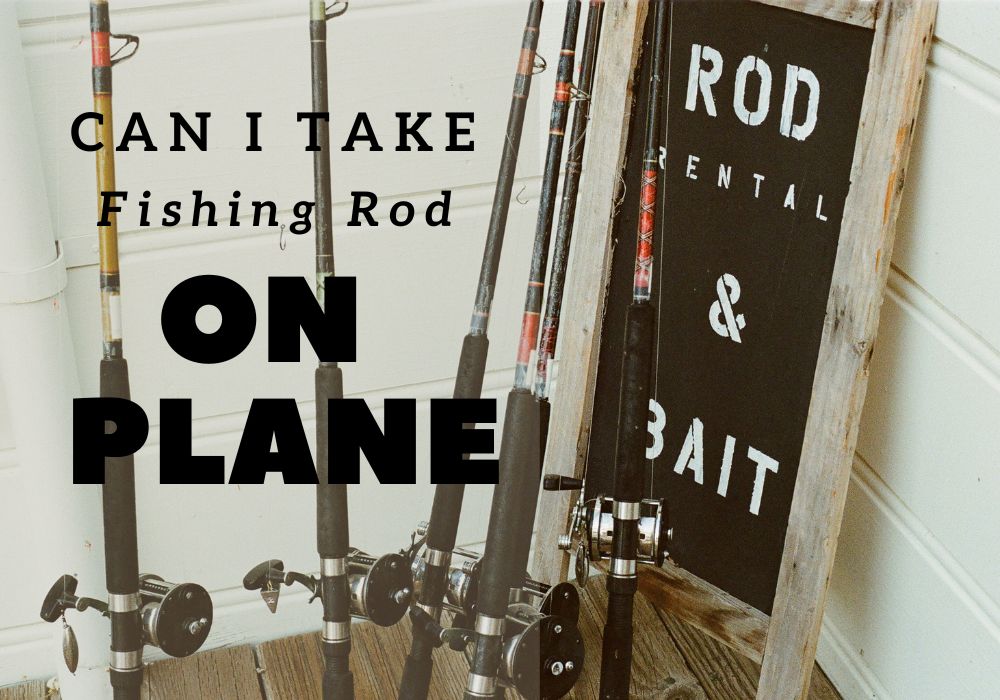Yes,
But there are some rules and regulations that you need to follow. In this blog, we will guide you through the airline policies about Can I Take A Fishing Rod On A Plane?, how to pack them properly and other essential fishing gear that you might need. We will also discuss alternatives to carrying your fishing rod on a plane and any restrictions related to taking fishing bait with you. So, whether it’s your first time traveling with your fishing gear or you’re a frequent traveler looking for some tips, this post has got you covered.
Table of Contents
Understanding Airline Policies for Fishing Rods
Before flying, familiarize yourself with airline regulations on transporting fishing rods. Conduct thorough research as different airlines may have varying rules. Pack your rod properly by securing it in a short rod tube or cylindrical container. Consider any airline-specific policies and purchase necessary equipment for secure transportation. Remember to pack enough flies, reels, and lines based on the type of fishing you plan to do.
By researching, securing, and packing properly, you can ensure your gear arrives safely at your destination for an enjoyable fishing adventure. A sturdy rod case or tube is your best bet to ensure that your rod arrives in the same condition it left.
The Common Rules and Regulations
When traveling with fishing rods, it’s important to know the rules enforced by airlines. Most airlines allow fishing rods as checked luggage but not as carry-on items due to their size and security concerns. To ensure safe transportation, disassemble the rod and pack it in a case or tube that meets weight restrictions. Stay informed about airport security regulations to avoid any problems. By following these rules, you can travel with your fishing gear hassle-free.
Airline-Specific Policies
When flying with a fishing rod, it’s important to know the airline’s specific policies. Each airline has different regulations, including Alaska Airlines, which waives the oversize fee for fishing equipment and has standard charges as for regular baggage. A piece of fishing equipment should not be linearly larger than 115 inches and should contain no more than two rods, one tackle box, and two reels.
Familiarize yourself with the airline’s policies, such as Alaska Airlines, to ensure a smooth journey and avoid any issues at the airport.
Packing Fishing Rods for Air Travel

Properly securing your fishing rod is crucial to ensure its safety during air travel. One effective method is to disassemble the rod into separate sections, making it easier to pack and protecting it from rough handling. Additionally, using bubble wrap can provide extra protection for fragile tackle, such as fishing reels. To store your fishing rod, using a rod case or tube that tightly secures it is the best option, preventing any potential damage. Short fishing rods can be accommodated in a small rod tube, while longer rods may require a larger case.
By taking these precautions, you can safeguard your precious gear and have peace of mind knowing that your fishing rod will arrive safely at your destination.
The Right Way to Secure Your Fishing Rod
The Right Way to Secure Your Fishing Rod
To ensure your fishing rod’s safety during air travel, follow these steps:
By taking these precautions, you can ensure that your gear arrives in perfect condition for an enjoyable fishing experience at your destination.
By taking these precautions, you can ensure that your gear arrives in perfect condition for an enjoyable fishing experience at your destination.
Tips for Packing Reels and Lines
When packing your fishing gear for air travel, it’s important to care for your reels and lines. Clean them to remove saltwater or dirt, ensuring they are in good condition. Store the reel in a case or bag to prevent scratches during transit.
Consider removing fragile or expensive fishing line to avoid tangling. If keeping the line on, secure it with tape or rubber bands.
Place the reel, lines, and extra equipment in a rod case or tube for organization and protection. A cylindrical fishing rod container is ideal for international anglers or those with multiple rods.
Follow these tips to pack your reels and lines safely, ready for unforgettable fishing experiences.
Can I Take A Fishing Rod On A Plane?

Other Essential Fishing Gear for Plane Travel
When traveling with fishing gear by plane, it’s important to consider more than just your fishing rod. To transport small lures and hooks, follow the TSA guidelines by packing them in tackle boxes or small containers. Ensure the tackle box is securely closed to prevent loose hooks during the flight.
For international flights, research fishing fly restrictions in specific countries as regulations may vary. Pay attention to weight restrictions for checked baggage, especially for large fish hooks. Check with your airline for any additional restrictions.
Remember to pack your gear properly in a cylindrical fishing rod container or short rod tube to protect it. Plan ahead and be aware of regulations for a smooth journey to your fishing destination.
Carrying Lures and Hooks on the Plane
When traveling with fishing equipment, it’s important to understand the rules and regulations for lures and hooks on planes. To comply with carry-on restrictions, ensure your tackle box or container is small enough. Use bubble wrap or cushioning material to prevent damage. While it’s best to pack these items in checked baggage, airport security measures may vary.
For fly fishing, consider carrying small flies in fly boxes and check weight restrictions. Stay updated on airport security regulations for a smooth journey. Following these guidelines, including properly securing sharp fishing tackle, protects your gear during travel.
Flying with Additional Fishing Equipment
When traveling with fishing equipment, check the airline’s policies. Different airlines have different rules. Some may allow extra fishing gear as checked baggage, while others may charge excess fees. Protect fragile items like rods and expensive reels by wrapping them in bubble wrap. Pack only necessary equipment to save space. Check your airline’s rules before your trip for a smooth experience.
Alternatives to Carrying Your Fishing Rod on a Plane
If the hassle of taking fishing gear on the plane is not appealing, there are alternatives to consider. One option is to rent fishing equipment at your destination. Look for fishing equipment rental services or saltwater fishing charters in the area you will be visiting. Renting fishing gear can save you the trouble of lugging your own fishing rods and tackle on the plane.
Another alternative is to ship your fishing equipment to the destination in advance. This ensures that it arrives safely and on time, without the need for you to carry it on the plane. It’s important to evaluate the costs and convenience of these alternative options before deciding on the best way to enjoy your fishing adventure. By exploring these alternatives, you can focus on the excitement of catching fish without the worry of carrying your precious gear on the plane.
Are There Any Restrictions on Taking Fishing Bait on a Plane?

When traveling with fishing gear, it’s essential to check the transportation security administration website for any restrictions on taking fishing bait on a plane. Pack your fishing tackle properly in checked luggage, following weight restrictions. Ensure fragile tackle is bubble wrapped for added protection during handling. Follow the airlines’ guidelines for sporting equipment and enjoy your fishing trip!
Frequently Asked Questions
Does American Airlines allow fishing rods as carry-on?
Yes, fishing rods can be carried on American Airlines. However, it is important to ensure that they are properly packaged and meet the airline’s size and weight requirements. Contact the airline beforehand to confirm their guidelines and be aware that additional fees may apply.
How long of a fishing rod can I bring on a plane?
The maximum length of a fishing rod you can bring on a plane may vary depending on the airline and destination. Some airlines allow rods up to 9 feet, while others may have different restrictions on the number of rods allowed. It’s important to check with the airline beforehand and pack the rod securely in a hard-sided case to prevent damage. If your rod exceeds size limits, consider shipping it separately.
Can you bring a fishing pole as a carry-on Southwest?
Southwest allows passengers to bring fishing poles as carry-on items, but they must adhere to the airline’s size restrictions. To prevent damage, it’s important to securely pack the fishing pole in a case or tube. Check with Southwest for any specific regulations or fees before your trip, and arrive early at the airport to allow time for the security screening of your fishing pole.
Why were fishing rods confiscated by TSA?
Fishing rods can be confiscated by TSA if they don’t meet size and weight restrictions. Airlines may also have their own policies on fishing equipment. TSA may confiscate rods if they’re seen as a security threat. Always check with your airline and TSA guidelines before traveling with fishing gear.
What other fishing gear is allowed on a plane?
You can bring reels, hooks, and lures in your carry-on or checked luggage. However, sharp objects like knives and scissors should be packed in checked luggage. Fishing lines are allowed in checked luggage, but they may be subject to inspection. Don’t forget to check with your airline for any specific restrictions on fishing gear.
Is live fish allowed in the airport?
Live fish are generally not permitted in airports or on flights. However, airlines usually allow frozen or dried seafood as long as it adheres to their baggage restrictions. Before bringing a fishing rod on a plane, make sure to check with the airline for their specific rules. It’s recommended to pack the rod in a hard-shell case for protection during transport.
Conclusion and final thoughts
In conclusion, it is possible to take a fishing rod on a plane, but it is essential to understand the airline policies and pack your fishing gear correctly. Different airlines may have specific regulations regarding the size, weight, and packaging of fishing rods. Make sure to secure your fishing rod properly and pack your reels and lines carefully to avoid any damage during transit. Additionally, be aware of any restrictions on carrying lures, hooks, or other fishing equipment on the plane. If you are unsure about the airline policies or prefer not to carry your fishing rod, there are alternatives available such as renting fishing gear at your destination.
Always check with the airline beforehand and plan accordingly to ensure a hassle-free journey for your fishing adventure.





Leave a Reply